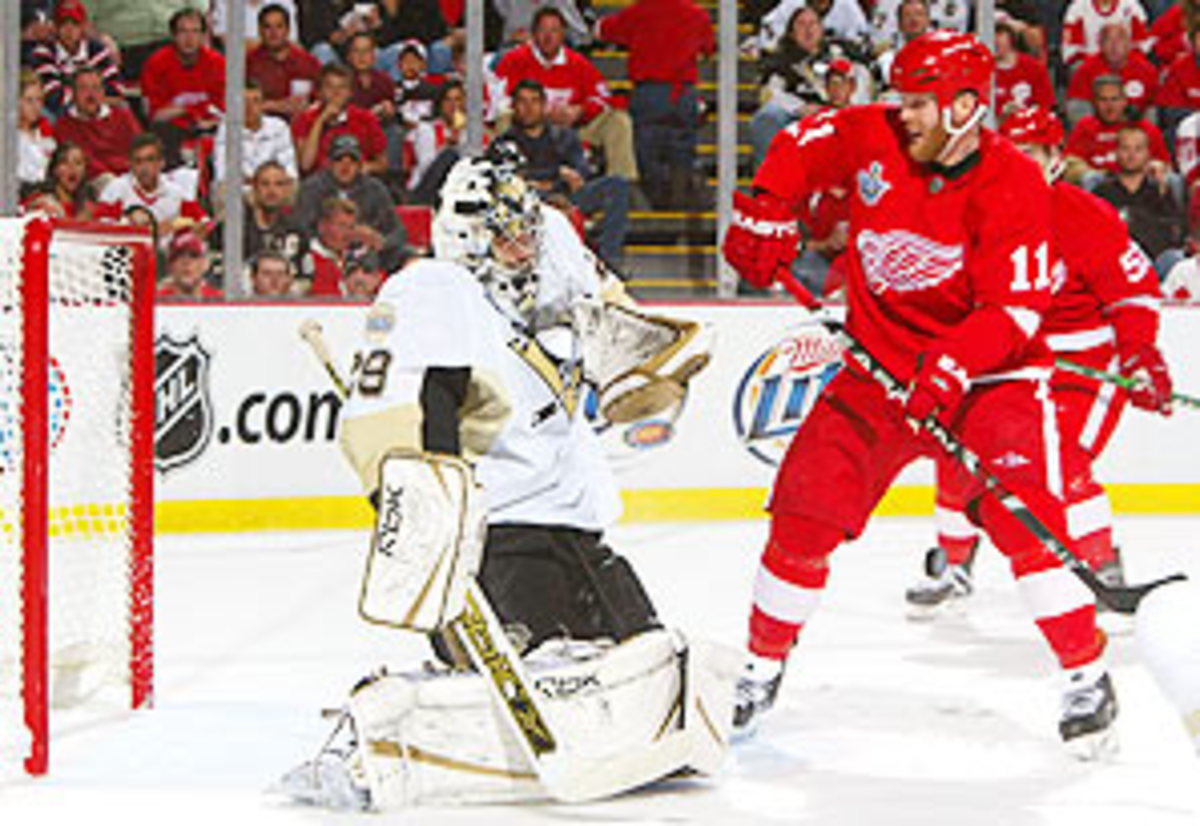Fleury must stand tall between pipes for the Penguins
Game 2 is obviously of great import for the Pittsburgh Penguins. So much so that Michel Therrien is transplanting heart and soul veteran Gary Roberts (shouldn't there be an "extreme veteran" category for competitors beyond the age of 40?) and juggling his lines. Those are the obvious adjustments, but a whole lot more has to change if the Pens are to avoid a two-game deficit in the series.
Let's begin with the goalies. Chris Osgood, 35, finished with only 19 saves for the Wings, but more pertinently, he began with 12 in the first. He made a handful of quality saves that kept the score at zero, allowing his mates to get their game in gear. Osgood's performance was vintage playoff in its delivery: crucial saves in their timing and effect on the game.
Meanwhile, the Penguins' 23-year-old Marc-Andre Fleury was excellent early (adrenaline?), but made crucial mistakes after that -- including over-committing on the strong side, which put him out of position on the game's uber-important first goal. Sure, he made several-dazzling saves in the second and third period when the Red Wings dramatically tipped the ice in their favor. Still, the Stanley Cup stage is where the adage "a goalie is measured by the goals he gives up and not the saves he makes" is true in its purest context.
Tonight Fleury will still have to make some sparkling saves. But it is essential that he eliminates the gaffes -- including rebound control and puck-handling situations. At the other end, Osgood has lived both sides of the saying and knows the depth of its meaning to his core. That's why the Penguins desperately need to get more shots on goal and definitely have to find a way to manufacture second chance opportunities.
That brings us to the crux of what needs to change for the Penguins overall: They need to compete a lot harder. The Red Wings outworked the Penguins in the first game. The Red Wings owned loose pucks along the boards and short rebounds in front of Osgood. The forwards initiated contact that was purposeful more so than punishing, forcing turnovers. The Wings' defensemen deftly held the offensive blueline to keep plays alive and stepped up aggressively in the neutral zone to disrupt the Pens' transition attack.
Sounds like a litany of deficiencies, but all have root in the Penguins' work rate. Yes, the Red Wings can numb a team with their nimble puck movement. Still, the Pens can't get outworked or out-muscled. Their competitive level has to improve to dictate game flow in stretches and give their skill a chance to flourish. It won't work the other way around -- unless, of course, you're talking about special teams.
The great equalizer for the Red Wings has been the play of their power play and penalty-killing units. If they continue to thwart while down a man the way they did in the first period of Game 1, they'll gain a huge advantage -- practically and mentally.
The Penguins' power play has plenty of pop and yet went 0-4 in what could have been a game altering sequence in the first. They gain offensive swagger from power play effectiveness. Frustration is the opposite emotion when their power play sputters -- something the Red Wings are very capable of eliciting.
The Penguins have to simplify on the power play and get pucks and people to the net -- set up scramble situations and low-slot battle scenarios. Then it's all about determination in those situations.
The Penguins haven't lost back-to-back games in nearly three months, so they definitely have shown the ability to bounce back. In Game 2, the challenge is all theirs.






